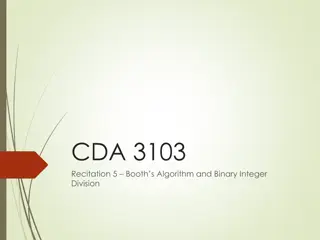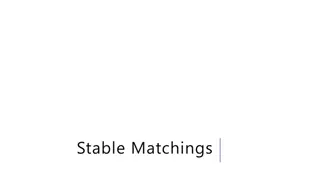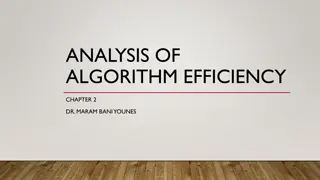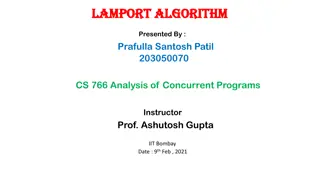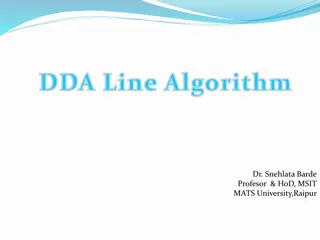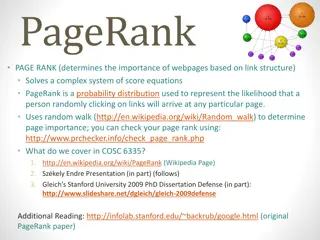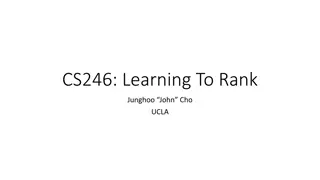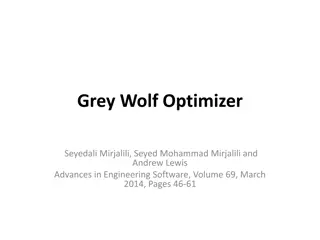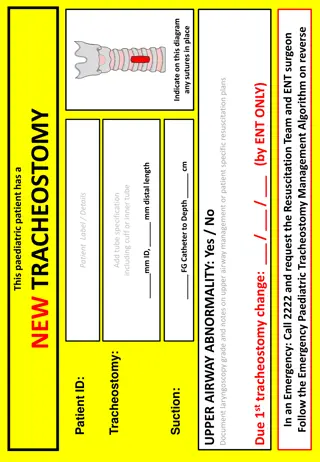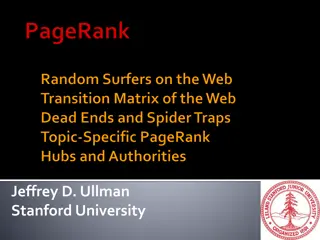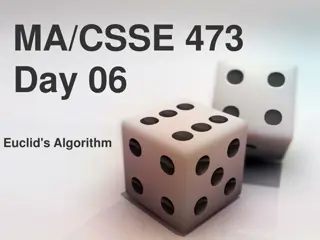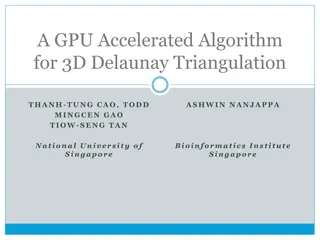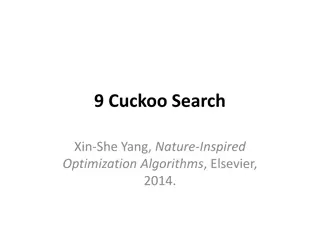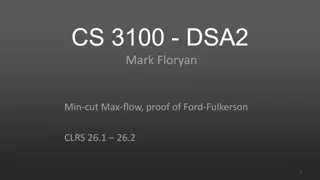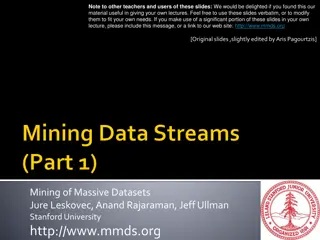PageRank Algorithm
A deep dive into PageRank algorithm for ranking web pages based on importance, addressing challenges of TFIDF and link-based ranking. Learn how link structure influences page popularity and explore solutions to link spamming. Discover the significance of page pointing and the matrix stochasticity in PageRank calculation.
Download Presentation

Please find below an Image/Link to download the presentation.
The content on the website is provided AS IS for your information and personal use only. It may not be sold, licensed, or shared on other websites without obtaining consent from the author.If you encounter any issues during the download, it is possible that the publisher has removed the file from their server.
You are allowed to download the files provided on this website for personal or commercial use, subject to the condition that they are used lawfully. All files are the property of their respective owners.
The content on the website is provided AS IS for your information and personal use only. It may not be sold, licensed, or shared on other websites without obtaining consent from the author.
E N D
Presentation Transcript
CS246: PageRank Junghoo John Cho UCLA
Problems of TFIDF Q: Using TFIDF, what pages are likely to be returned for the query Best Buy ? TFIDF works well on small controlled corpus, but not on the Web Do users really want to see pages that contain the word Best Buy many times for the query Best Buy? Easy to spam Ranking purely based on page content Authors can manipulate page content to get high ranking Q: How can search engine figure out the pages that users truly have in mind? 2
? ?(?) = 1 ? =? ? ? ? = 1) ? ? ? = 1 ?(?) TFIDF (or probabilistic model) ignore ? ? ? = 1 and focus only on ? ? ? ? = 1) But many Web pages share the same language model with the query Best Buy! We need know ? ? ? = 1 To find the ideal Best Buy page, we need ? ? ? = 1 , not just ? ? ? ? = 1) ? ? ? = 1 : Global popularity of page ? independent of query Q: How can we estimate ? ? ? = 1 ? A: Many approaches are possible Collect users bookmarks Collect users click data 3
Link-Based Ranking Basic idea People create a link to a page because they find the page useful Let us use link structure of the Web to measure a page s popularity/quality Example Many pages point to Best Buy home page with the anchor text Best Buy Q: How can we use the link structure to measure page popularity? 4
Simple Link Count Count the number of pages linking to the page Unfortunately, this does not work well Too easy to spam: create many new pages and add link to a spam page Q: Any way to avoid link spamming? 5
PageRank A page is important if it is pointed by many important pages ??(?) = ??(?1)/?1 + + ??(??)/?? ??: page pointing to ?, ??: number of links in ?? Division by ?? makes the matrix stochastic More discussion later PageRank of p is the sum of PageRanks of its parents Q: But the definition is circular! Is the definition well-founded? Can we solve the equations for ??(??) s? One equation for every page N equations, N unknown variables 6
Example Netflix, Microsoft and Amazon PR(n) = PR(n)/2 + PR(a)/2 PR(m) = PR(a)/2 PR(a) = PR(n)/2 + PR(m) Nf MS 1/2 0 1/2 0 0 1 1/2 1/2 0 ? ? ? ? ? ? = Am 7
PageRank: Matrix Notation Web graph matrix ? = { ??? } Each page i corresponds to row i and column i of the matrix M mij = 1/n if page i is one of the n children of page j mij = 0 otherwise ?1 ?2 ?3 PageRank equation: ? = ? ? Q: How can we calculate it? PageRank vector: ? = 8
PageRank: Iterative Calculation Initially assign equal importance 1 At each iteration, each page shares its importance among its children and receives new importance from its parents Repeat until the importance of each page converges Q: Is it guaranteed to converge? ?to every page 9
Example Nf 1/2 0 1/2 0 0 1 1/2 1/2 0 ? ? ? ? ? ? MS = Am / 1 / 1 3 3 5 / 12 / 3 8 5 / 12 2 / 5 n / 1 / 1 / 1 = 3 6 / 1 4 / 1 6 11 / 48 5 m / 1 / 1 3 2 / 1 3 11 / 24 17 / 48 2 / 5 a 10
PageRank as Eigenvector PageRank equation: ? = ? ? ? is the principal eigenvector of M The principal eigenvalue of a stochastic matrix is 1 11
PageRank and Random Surfer Model PageRank is he probability of a Web surfer to reach the page after many clicks, following random links Random Click 12
Problems on the Real Web Dead end A page with no links to send importance All importance leaks out of the Web Crawler trap A group of one or more pages that have no links out of the group Accumulate all the importance of the Web 13
Example: Dead End No link from Microsoft Dead end Nf 1/2 0 1/2 0 0 0 1/2 1/2 0 ? ? ? ? ? ? = MS Am 14
Example: Dead End Nf 1/2 0 1/2 0 0 0 1/2 1/2 0 ? ? ? ? ? ? MS = Am / 1 / 1 3 3 / 1 4 5 / 24 / 1 6 0 n / 1 / 1 / 1 = 12 3 6 / 1 12 / 1 16 0 m / 1 / 1 / 1 6 3 6 / 1 8 5 / 48 0 a Q: How can we avoid the dead-end problem? 15
Solution to Dead End Option 1: Remove all dead end Q: Does it really solve the problem? Option 2: Assume a surfer to jumps to a random page at a dead end 1/2 0 1/2 1/3 1/3 1/3 1/2 1/2 0 ? ? ? ? ? ? Nf = MS Am 16
Example: Crawler Trap Only self-link at Microsoft Crawler trap Nf 1/2 0 1/2 0 1 0 1/2 1/2 0 ? ? ? ? ? ? = MS Am 17
Example: Crawler Trap Nf 1/2 0 1/2 0 1 0 1/2 1/2 0 ? ? ? ? ? ? MS = Am / 1 / 1 3 3 / 1 4 5 / 24 / 1 6 0 n / 1 / 1 = 3 2 7 / 12 2 / 3 35 / 48 1 m / 1 / 1 3 6 / 1 6 / 1 8 5 / 48 0 a Q: How can we avoid this problem? 18
Crawler Trap: Damping Factor Create an exit path in every page! Probability to jump to a random page ?? ?? ?? ??(??) = ? + (1 ?)/? ? Assuming 20% random jump 7 / 33 n 1/2 0 1/2 0 1 0 1/2 1/2 0 1/3 1/3 1/3 ? ? ? ? ? ? = 7 / 11 m = 0.8 + 0.2 5 / 33 a 19
Crawler Trap: Damping Factor Random surfer interpretation A surfer gets bored after a few clicks and randomly jumps to another page Damping factor makes the graph a fully-connected graph Ensures convergence from iterative computation method 20
Link-Spam Problem Q: What if a spammer creates a lot of pages and create a link to a single spam page? PageRank better than simple link count, but still vulnerable to link spam Q: Any way to avoid link spam? 21
TrustRank [Gyongyi et al. 2004] Good pages don t point to spam pages Trust a page only if it is linked by what you trust ?? ?? ?? ?? ?? = ? + ?? ? ??= (1 ?)/?? if ?? is trusted otherwise 0 Same as PageRank except the random jump probability term 22
TrustRank: Theory [Bianchini et al. 2005] ? ?? ?? Given ? ?? = ? ? consider a set of pages ? + ??, IN(S) S OUT(S) DP(S)
TrustRank: Theory [Bianchini et al. 2005] ??= ?? ??(??) ????= ?? ???(?)?(??)/?? ???= ?? ??(?)?(??)/?? ??= ?? ??? ???= ?? ??(?)?(??) ? ? ? ??= ??+ 1 ???? 1 ????? 1 ???? 24
What Does It Mean? ??= ??+ ???? ????? ???? Note: ??= 0 if ??= 0and ???= 0 You cannot improve your TrustRank simply by creating more pages and linking within yourself To get non-zero TrustRank, you need to be either trusted or get links from outside 25
Is TrustRank the Ultimate Solution? Not really Honeypot: A page with good content with hidden links to spams Good users link to honeypot due to its quality content Blogs, forums, wikis, mailing lists Easy to add spam links Link exchange Set of sites exchanging links to boost ranking A never-ending rat race 26
References [Gyongyi et al. 2004] Z. Gy ngyi, H. Garcia-Molina, J. Pedersen: Combating Web Spam with TrustRank, VLDB Conference 2004 [Bianchini et al. 2005] Monica Bianchini, Marco Gori, and Franco Scarselli: Inside PageRank, ACM Transactions on Internet Technology 5(1), February 2005 27






